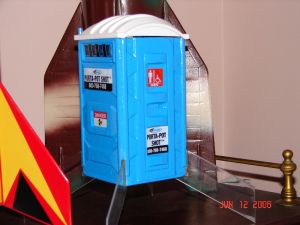| Construction Rating: | starstarstarstarstar_border |
| Flight Rating: | starstarstarstarstar_border |
| Overall Rating: | starstarstarstarstar_border |
| Manufacturer: | Estes  |

Brief:
This is a new Estes Kit. It is a single stage kit and recovery is by parachute
and also a white streamer meant to look like toilet paper. (I don't make this
stuff up...)
Construction:
The body itself is styrofoam and comes in two sections. The roof of the rocket
is made of hard plastic. It also has four clear plastic fins that attach to the
bottom of the kit in order to make it stable for flight. Clay nose cone weight
is also provided.
The build only takes about an hour or so. The instructions were typical Estes high quality with one potential "gotcha". The kit comes with two heat shields, one for the roof and one for the bottom of the model. In the instructions you are told to attach the top and bottom heat shields before the fins are attached. If you do this on the bottom of the kit, you would have to cut through the shield to insert the fins easily in my opinion. It's best to attach the bottom shield before gluing the fins in.

Finishing:
A PRO regarding finishing would be that it's fairly straightforward.
CONs are as mentioned above that the heat shield attachment needing to be done before fin placement. Also painting is a potential issue. The kit tells you only to use styrofoam safe paint on the body, which I couldn't find, so I actually used Testor's model paint on the body. I used regular white spray paint for the roof and the fins I left clear.
I mixed Testor's blue and white paint to come close to the package paint scheme and I think I nailed it pretty good. I painted three coats on and it really looks great. I normally don't like to use brush on paint on models because I can never get the finish right, however, on the styrofoam, it went on without a brush mark. Decals are stick on, not water slide, and they worked great for this kit.
Construction Rating: 4 out of 5
Flight:
Prep is fairly easy, aside from having to cram the 12 inch chute into the small
tube inside the body of the rocket. There just isn't much space to put the
chute into along with a couple sheets of recovery wadding. The chute basically
sits right on top of the engine and it's a very tight fit.
There was a prevailing wind of 18-20 miles per hour. We were right near the coast in Rhode Island and I was not crazy about launching the rocket under those conditions, but my son had his heart set on seeing it fly. I decided to forgo the recommended B6-2 engine and move to a C. I didn't have any C6-3s with me so it was flown on a C6-5.
The rocket flew fairly straight under the circumstances. It didn't fly very high though, maybe 150 feet or so. It really had to fight for altitude being shaped like an outhouse, along with battling the heavy wind coming off of the ocean. The 5 second delay was too long. I suspect on a day without wind that a C6-3 would be a great flight. Ejection on this flight was only about 60 feet above ground and since the chute is so tightly compressed into the compartment, it didn't open in time. It acted like a streamer and the rocket came down too quickly. However, since we launched in a hay field there was no damage. If it had been a regular field or pavement, the clear fins would have snapped for sure and probably the foam body would have been damaged.
Recovery:
Amazingly, the chute itself was not burned even though it sat right on top of
the engine. It looked great post-flight. There was some slight scorching to the
underside heat shield that prevents the foam body from being burned during
takeoff, however, the rocket itself is in excellent shape. I am looking forward
to launching this rocket in a no winds from a regular field using a C6-3. I
will not be using a B engine on this rocket since it just doesn't fly that
high. The chute needs time to unfold and grab air and I doubt a B engine will
give it that time. Either way, I am not going to chance it. This is a great
looking conversation piece rocket that actual flies and it's not going to get
away from anyone on a C6-3 engine.
Flight Rating: 4 out of 5
Summary:
I really like the kit because it is unique and a real conversation piece, at
least with people who have a good sense of humor. Also, the saying on the front
of the package "Fly the crap out of it" gave me a good laugh also.
Overall Rating: 4 out of 5
 |
 |
Flights
 |
 |
S.K. (March 6, 2007)
K.L.M. (April 13, 2008)
Sponsored Ads
 |
 |












D.E.B. (December 28, 2006)